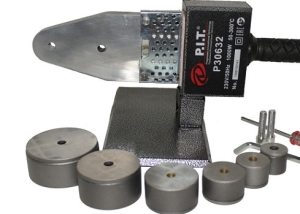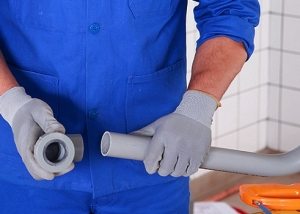For a long time, metal pipes had no alternative when constructing a water supply system in conditions of private house-building, which were connected by a thread and a welding machine. At the moment, outdated technology is actively displacing the pipeline from light synthetic analogues from plastic, metal-plastic and polypropylene. Their performance is not inferior to metal pipes. They do not rust, the smooth surface of the polymers does not contribute to the deposition of sediment. Simple installation involves an inexpensive special apparatus and nozzles for a soldering iron for polypropylene pipes.

Soldering iron for soldering polypropylene pipes is equipped with nozzles for pipes of different sizes
Content
The principle of operation of the soldering iron and nozzles
A special soldering iron for rations of polypropylene pipelines is popular among employees of small firms engaged in home repairs. Docking and installation of constituent water pipes is done by equipment for cutting and soldering joints. The soldering tool works on the principle of an iron and is completely reliable for self-jointing of synthetic pipes at home. It is worth remembering that nozzles for a soldering iron are selected for pipes of different diameters.
Although welding is also used for polypropylene pipes, it only vaguely resembles a welding machine for metal work. A special soldering iron for flexible ducts heats the connected segments and fittings to a temperature that is quite enough for joining. But it is impossible to melt metal with such a device.
Attention! An important role is given to nozzles, which should be suitable for the diameter and shape of the products. When purchasing a soldering iron, you need to carefully familiarize yourself with the operating characteristics of the equipment, which are indicated in its instructions or certificates.
Selection of welding equipment for polypropylene pipes
Models of welding equipment for polypropylene water supply are largely similar. The main difference is the way the nozzles are fixed to the heating element. For example, companies from Germany offer nozzles for soldering irons of various types, which are suitable for xiphoid and rod tools. It is best to use a soldering iron, which is suitable for 3 types of nozzles of different sizes. This simplifies the installation process when joining segments of different diameters or other materials. Often it is assumed the use of Teflon nozzles for brazing polypropylene pipes having the best non-stick indicators.
The simplest soldering iron is:
- main part (case) with a handle;
- a welding element resembling a heater or "iron";
- Temperature regulator;
- a set of interchangeable nozzles.

Devices for soldering polypropylene pipes come in different types, but the principle of operation is similar for everyone
The similarity with the principle of operation of the iron lies in the fact that they have a temperature controller and a heating element. TEN of a soldering iron is located in a casing of round or flat shape. It depends on what components are suitable for this form of soldering iron housing for polypropylene pipes.
The principle of the soldering iron:
- TEN heats up from the power supply network, transferring temperature to nozzles;
- nozzles in the form of caps heat up the polypropylene until soft, and a viscous polymer is used for hermetically soldering;
- the molten parts of the pipes are joined, the connection is maintained for a certain time for cooling.
If the nozzle is heated excessively, the joint may overheat, and the fusion joint reduces the passability of the pipes being connected. Pipeline damage due to inept use of a pipe soldering iron.
Worth considering! The optimum temperature for the operation of the heated nozzles is within + 260 ° С. These indicators are monitored by a temperature regulator so that the tips for the soldering iron of polypropylene pipes do not overheat.
But the connection of synthetic pipes of different diameters suggests a slight deviation:
- temperature range;
- by the time of heating the polypropylene nozzle;
- accuracy of soldering;
- the necessary time for cooling the pipes.
Before starting work, it is worth clarifying such points:
1. Carefully read the instructions for use of the welding machine for the installation of polypropylene communications. European manufacturers often indicate the parameters of soldering tips for polypropylene pipes, which must be purchased separately or include a minimum set. They are quite enough for one-time work in a private home. If necessary, purchase additional nozzles of a similar shape and size.

Nozzles should be selected with a Teflon coating, such products are more durable and convenient to use.
2. Expensive tools and the highest quality nozzles are bought by professionals - repair crews and construction companies. But even the simplest “iron” with high-quality nozzles for soldering synthetic pipes will provide high-quality water supply installation.
3. When choosing a tool and accessories, the non-stick Teflon layer of Teflon is important, which ensures uniform heating of the ends of the pipes made of polypropylene. It is easy to remove heated parts from Teflon; polymer does not stick to such a coating.
4. The working power of the tool affects the heating and soldering times. The more powerful the tool, the more expensive it is and is used even to melt the ends of thick pipes. In everyday life, there is no need for a powerful device.
The choice of nozzles for mounting pipes made of polypropylene
A household hand-held soldering iron is designed for joining polymer pipes with a diameter of up to 63 mm, matching with two-inch metal pipes. Often nozzles are sold along with equipment, that is, they are initially included in the kit. Standard nozzles:
- No. 20 for soldering pipes with a diameter of 0.5 inches;
- No. 25 - for a diameter of 0.75 inches;
- No. 40 - for a pipe diameter of 1.25 inches.
Special nozzles of another indexation go to large pipes.
Masters of specialized companies work with pipes of any size - ranging from 10 mm to 110 mm, at home they use standard pipes and nozzles - No. 20, No. 25 and No. 40.
Note! Cylindrical nozzles are produced from different metals, but high-quality ones are always covered with a layer of non-stick Teflon. Without it, smoke appears during soldering, the remains of the molten polypropylene remain on the surface, sticking or burning is possible. So you can save on the device itself and its power, but the quality of the nozzles for the soldering iron is not worth it.

For domestic conditions, a small set of nozzles is enough, where the largest is suitable for a pipe with a diameter of 63 mm
How are pipes soldered?
Installation of a polypropylene water pipe in a domestic environment is not as complicated as it might seem to a beginner:
- Pipe cutting is done strictly perpendicular, since the quality of the joint directly depends on the accuracy of the razki. It is also necessary to remove aluminum foil if the pipe is reinforced.
- The bevel is necessarily removed from the end of the polypropylene, burrs and other irregularities are ground.
- The soldering iron is supplied with a nozzle of the required size, is connected to a ground outlet and the red button is turned on. The indicator light confirms the start of heating.
- Upon completion of the heating of the tool to 260 ° C, the red color of the indicator goes out, and you can work with the connected ends. The end of the pipe and the fitting for articulation are inserted into the nozzles. It takes 5-7 seconds to warm up, during which time their edges melt.
- The molten edges are immediately gently removed, connecting the hot ends. Remember that the nozzles on the soldering iron for polypropylene pipes must be fixed securely so that they do not hang.
- Polypropylene cools as fast as it warms up - literally in a minute the molten polymer “seizes” and cools.
- When connecting hot ends, you can not rotate pipes and fittings, make other movements or try to “fix” something. This will damage the joint or make the joint brittle.
- The pipeline, upon completion of the soldering process and complete cooling, is ready for operation.
Advice! To be sure of the quality of the articulation of the ends, it is better to fix the pipes in a horizontal position. If the process of welding polypropylene in a vertical position is inevitable, then the lower edge is fixed, and the quality of the connection should be monitored by an assistant holding the upper pipe in a vertical position. Use a plumb bob or universal construction tool.
Features of the connection of polypropylene and plastic pipes
In everyday life, parts of a pipeline can consist of different materials, including metal-plastic, plastic, metal and high-density polypropylene. This often happens in apartment buildings and cottages of dense development, when everyone changes the pipes at their discretion. Sometimes they change not the whole system, but only a leaky fragment.

In addition to the correct choice of tool and nozzle to it, it is also important to strictly observe the soldering technology
To join the metal-plastic pipeline with the polypropylene section, a detachable fitting with an external thread is used. The threaded fitting is fused to the end face of polypropylene in advance, and these ends are twisted with a sealant (tow, linen, fum tape). If there are doubts about the tightness, you can pour silicone and put the clamp. Such a connection must withstand the load typical of a water supply system. For surfacing a polypropylene part, a soldering iron with a nozzle of the appropriate diameter is used.
To do this, a fitting must be screwed onto the tee, onto which the end of the connected communication is attached using a nozzle for a soldering iron for polypropylene pipes. Perhaps the installation of the tee will take a lot of time - turning off the water supply, cutting plastic and installation work.
Joining a polypropylene pipeline is a simple event, and with reliable equipment and high-quality nozzles, everything should work out the first time. You only need to concentrate and do everything carefully and quickly, fix the pipes in a horizontal position, and make the ends cut strictly perpendicularly.





